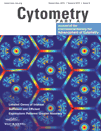|
Purpose:
|
Various forms of immunotherapy, such as checkpoint blockade immunotherapy, are proving to be remarkably effective at restoring T cell mediated immune responses that can lead to dramatic and sustained clinical responses but only in some patients and cancer types. Unpredictable responsiveness may be partly due to heterogeneity of the immune composition and phenotypic profiles of TILs within individual tumours and between patients. Although there is evidence that tumour-mutation derived neoantigen specific T cells play a role in tumour control, in most cases the antigen-specificities of phenotypically diverse tumour infiltrating T cells are largely unknown. Here we show that human lung and colorectal cancer CD8+ TILs can not only be specific for tumour antigens (e.g. neoantigens), but can also recognize a wide range of cancer-unrelated epitopes (e.g. from EBV, HCMV or Influenza virus). We found that these bystander CD8+ TILs have diverse phenotypes that overlap with tumour-specific cells, but lack expression of CD39. In colorectal and lung tumours, the absence of CD39 by CD8+ TILs defines populations whose phenotypes lack hallmarks of chronic antigen stimulation at the tumour site, supporting their classification as bystanders. Expression of CD39 varied dramatically between patients, with some patients having predominantly CD39? CD8+ TILs. Furthermore, frequencies of CD39 expression correlated with some important clinical stratifications, such as lung tumour EGFR mutation status. Our results demonstrate that not all tumour-infiltrating T cells are tumour-specific, and suggest measuring CD39 expression as a straightforward way to quantify or isolate bystander T cells. |

